Cathepsin L Inhibitors with Activity against the Liver Fluke Identified From a Focus Library of Quinoxaline 1,4-di-N-Oxide Derivatives
Abstract
1. Introduction
2. Results and Discussion
2.1. Screening of Quinoxaline 1,4-di-N-Oxide Derivatives as FhCL1 and FhCL3 Inhibitors
2.2. Screening of Cathepsin L Inhibitors against NEJ
2.3. Analysis of Hit Compounds
2.4. Cathepsin Inhibitors Are Slow-Binding and Interact at the Active Site Cleft
2.5. Selectivity Assessment against Human Cathepsin L
2.6. Cytotoxicity Evaluation in Bovine Sperm and a Human Cell Line
3. Conclusions
4. Materials and Methods
4.1. Production of Recombinant FhCL1 and FhCL3
4.2. FhCL1 and FhCL3 Inhibition Screening
4.3. In Vitro Culture of NEJ and Treatment with the Best Inhibitors
4.4. Characterization of the Best Inhibitors
4.4.1. IC50, Time-Dependence of Inhibition, and HsCL Testing
4.4.2. Ligand-Protein Molecular Docking to Predict the Binding Site into FhCL1 and FhCL3
Preparation of Protein Structures
Preparation of Ligand Structures
Ligand-Protein Molecular Docking
4.4.3. Ligand-Protein Molecular Dynamics MD Simulations
4.5. Cytotoxicity Assay on the HepG2 Cell Line and Bovine Spermatozoa
Supplementary Materials
Author Contributions
Funding
Acknowledgments
Conflicts of Interest
References
- Spithill, T.W.; Smooker, P.M.; Copeman, D.B. Fasciola gigantica: Epidemiology, control, immunology and molecular biology. In Fasciolosis; Dalton, J., Ed.; CAB International: Wallingford, UK, 1999; pp. 426–525. [Google Scholar]
- Mas-Coma, S.; Bargues, M.D.; Valero, M.A. Human fascioliasis infection sources, their diversity, incidence factors, analytical methods and prevention measures. Parasitology 2018, 145, 1665–1699. [Google Scholar] [CrossRef] [PubMed]
- Webb, C.M.; Cabada, M.M. Recent developments in the epidemiology, diagnosis, and treatment of Fasciola infection. Curr. Opin. Infect. Dis. 2018, 5, 409–414. [Google Scholar] [CrossRef] [PubMed]
- Carmona, C.; Tort, J.F. Fasciolosis in South America: Epidemiology and control challenges. J. Helminthol. 2017, 2, 99–109. [Google Scholar] [CrossRef] [PubMed]
- Kelley, J.M.; Elliott, T.P.; Beddoe, T.; Anderson, G.; Skuce, P.; Spithill, T.W. Current Threat of Triclabendazole Resistance in Fasciola hepatica. Trends Parasitol. 2016, 32, 458–469. [Google Scholar] [CrossRef] [PubMed]
- Lanusse, C.; Canton, C.; Virkel, G.; Alvarez, L.; Costa-Junior, L.; Lifschitz, A. Strategies to Optimize the Efficacy of Anthelmintic Drugs in Ruminants. Trends Parasitol. 2018, 34, 664–682. [Google Scholar] [CrossRef]
- Molina-Hernández, V.; Mulcahy, G.; Pérez, J.; Martínez-Moreno, Á.; Donnelly, S.; O’Neill, S.M. Fasciola hepatica vaccine: We may not be there yet but we’re on the right road. Vet. Parasitol. 2015, 208, 101–111. [Google Scholar] [CrossRef] [PubMed]
- Dalton, J.P.; O Neill, S.; Stack, C.; Collins, P.; Walshe, A.; Sekiya, M.; Doyle, S.; Mulcahy, G.; Hoyle, D.; Khaznadji, E.; et al. Fasciola hepatica cathepsin L-like proteases: Biology, function, and potential in the development of first generation liver fluke vaccines. Int. J. Parasitol. 2003, 33, 1173–1181. [Google Scholar] [CrossRef]
- Cancela, M.; Acosta, D.; Rinaldi, G.; Silva, E.; Durán, R.; Roche, L. A distinctive repertoire of cathepsins is expressed by juvenile invasive Fasciola Hepatica. Biochimie 2008, 10, 1461–1475. [Google Scholar] [CrossRef]
- Cancela, M.; Ruétalo, N.; Dell’Oca, N.; da Silva, E.; Smircich, P.; Rinaldi, G. Survey of transcripts expressed by the invasive juvenile stage of the liver fluke Fasciola hepatica. BMC Genomics 2010, 11, 227. [Google Scholar] [CrossRef]
- Robinson, M.W.; Tort, J.F.; Lowther, J.; Donnelly, S.M.; Wong, E.; Xu, W. Proteomics and phylogenetic analysis of the cathespin L protease family of the helmith pathogen Fasciola hepatica: Expansion of a repertoire of virulence associated factors. Mol. Cell. Prot. 2008, 6, 1111–1123. [Google Scholar] [CrossRef]
- Corvo, I.; Cancela, M.; Cappetta, M.; Pi-Denis, N.; Tort, J.F.; Roche, L. The major cathepsin L secreted by the invasive juvenile Fasciola hepatica prefers proline in the S2 subsite and can cleave collagen. Mol. Biochem. Parasitol. 2009, 167, 41–47. [Google Scholar] [CrossRef] [PubMed]
- Cwiklinski, K.; Jewhurst, H.; McVeigh, P.; Barbour, T.; Maule, A.G.; Tort, J. Infection by the Helminth Parasite Fasciola hepatica Requires Rapid Regulation of Metabolic, Virulence, and Invasive Factors to Adjust to Its Mammalian Host. Mol. Cell. Proteomics 2018, 17, 792–809. [Google Scholar] [CrossRef] [PubMed]
- Lowther, J.; Robinson, M.W.; Donnelly, S.M.; Xu, W.; Stack, C.M.; Matthews, J.M.; Dalton, J.P. The importance of pH in regulating the function of the Fasciola hepatica cathepsin L1 cysteine protease. PLoS Negl. Trop. Dis. 2009, 3, e369. [Google Scholar] [CrossRef] [PubMed]
- McVeigh, P.; Maule, A.G.; Dalton, J.P.; Robinson, M.W. Fasciola hepatica virulence-associated cysteine peptidases: A systems biology perspective. Microbes Infect. 2012, 14, 301–310. [Google Scholar] [CrossRef] [PubMed]
- Ferraro, F.; Merlino, A.; Dell´oca, N.; Gil, J.; Tort, J.F.; Gonzalez, M.; Cerecetto, H.; Cabrera, M.; Corvo, I. Identification of Chalcones as Fasciola hepatica Cathepsin L Inhibitors Using a Comprehensive Experimental and Computational Approach. PLoS Negl. Trop. Dis. 2016, 10, 0004834. [Google Scholar] [CrossRef] [PubMed]
- Hernández-Álvarez, L.; Naranjo Feliciano, D.; Hernández González, J.E.; Soares, R.O.; Barreto Gomes, D.E.; Pascutti, P.G. Insights into the interactions of Fasciola hepatica cathepsin L3 with a substrate and potential novel inhibitors through in silico approaches. PLoS Negl. Trop. Dis. 2015, 9, e0003759. [Google Scholar] [CrossRef] [PubMed]
- Abdulla, M.H.; Lim, K.C.; Sajid, M.; McKerrow, J.H.; Caffrey, C.R. Schistosomiasis mansoni: Novel Chemotherapy Using a Cysteine Protease Inhibitor. PLoS Med. 2007, 4, e14. [Google Scholar] [CrossRef] [PubMed]
- Vermeire, J.J.; Lantz, L.D.; Caffrey, C.R. Cure of Hookworm Infection with a Cysteine Protease Inhibitor. PLoS Negl. Trop. Dis. 2012, 6, e1680. [Google Scholar] [CrossRef]
- Engel, J.C.; Doyle, P.S.; Hsieh, I.; McKerrow, J.H. Cysteine Protease Inhibitors Cure an Experimental Trypanosoma cruzi Infection. J. Exp. Med. 1998, 188, 725–734. [Google Scholar] [CrossRef]
- Steverding, D.; Sexton, D.W.; Wang, X.; Gehrke, S.S.; Wagner, G.K.; Caffrey, C.R. Trypanosoma brucei: Chemical evidence that cathepsin L is essential for survival and a relevant drug target. Int. J. Parasitol. 2012, 42, 481–488. [Google Scholar] [CrossRef]
- Sijwali, P.S.; Rosenthal, P.J. Gene disruption confirms a critical role for the cysteine protease falcipain-2 in hemoglobin hydrolysis by Plasmodium falciparum. Proc. Natl. Acad. Sci. USA 2004, 101, 4384–4389. [Google Scholar] [CrossRef] [PubMed]
- Liu, J.; Istvan, E.S.; Gluzman, I.Y.; Gross, J.; Goldberg, D.E. Plasmodium falciparum ensures its amino acid supply with multiple acquisition pathways and redundant proteolytic enzyme systems. Proc. Natl. Acad. Sci. USA 2006, 103, 8840–8845. [Google Scholar] [CrossRef] [PubMed]
- Li, Y.Y.; Fang, J.; Ao, G.Z. Cathepsin B and L inhibitors: A patent review (2010 present). Expert Opin. Ther. Pat. 2017, 27, 643–656. [Google Scholar] [CrossRef]
- Pereira, J.A.; Pessoa, A.M.; Cordeiro, M.N.D.; Fernandes, R.; Prudencio, C.; Noronha, J.P.; Vieira, M.; Cordeiro, M.N.D.S. Quinoxaline, its derivatives and applications: A State of the Art review. Eur. J. Med. Chem. 2015, 97, 664–672. [Google Scholar] [CrossRef]
- Ross, F.; Hernández, P.; Porcal, W.; López, G.V.; Cerecetto, H.; González, M.; Basika, T.; Carmona, C.; Fló, M.; Maggioli, G.; et al. Identification of thioredoxin glutathione reductase inhibitors that kill cestode and trematode parasites. PLoS ONE 2012, 7, e35033. [Google Scholar] [CrossRef] [PubMed]
- Vicente, E.; Charnaud, S.; Bongard, E.; Villar, R.; Burguete, A.; Solano, B.; Ancizu, S.; Pérez-Silanes, S.; Aldana, I.; Vivas, L.; et al. Synthesis and Antiplasmodial Activity of 3-Furyl and 3-Thienylquinoxaline-2-carbonitrile 1,4-Di-N-oxide Derivatives. Molecules 2008, 13, 69–77. [Google Scholar] [CrossRef] [PubMed]
- Dos Santos Fernandes, G.F.; Pavan, A.R.; Dos Santos, J.L. Heterocyclic N-oxides-A Promising Class of Agents against Tuberculosis, Malaria and Neglected Tropical Diseases. Curr. Pharm. Des. 2018, 24, 1325–1340. [Google Scholar] [CrossRef]
- Bhoj, P.S.; Ingle, R.G.; Goswami, K.; Jena, L.; Wadher, S. Apoptotic impact on Brugia malayi by sulphonamido-quinoxaline: Search for a novel therapeutic rationale. Parasitol. Res. 2018, 117, 1559–1572. [Google Scholar] [CrossRef]
- Mcgonigle, L.; Mousley, A.; Marks, N.J.; Brennan, G.P.; Dalton, J.P.; Spithill, T.W.; Day, T.A.; Maule, A.G. The silencing of cysteine proteases in Fasciola hepatica newly excysted juveniles using RNA interference reduces gut penetration. Int. J. Parasitol. 2008, 38, 149–155. [Google Scholar] [CrossRef]
- Beckham, S.A.; Piedrafita, D.; Phillips, C.I.; Samarawickrema, N.; Law, R.H.; Smooker, P.M.; Quinsey, N.S.; Irving, J.A.; Greenwood, D.; Verhelst, S.H.L.; et al. A major cathepsin B protease from the liver fluke Fasciola hepatica has atypical active site features and a potential role in the digestive tract of newly excysted juvenile parasites. Int. J. Biochem. Cell Boil. 2009, 41, 1601–1612. [Google Scholar] [CrossRef]
- Paveley, R.A.; Bickle, Q.D. Automated imaging and other developments in whole-organism anthelmintic screening. Parasit. Immunol. 2013, 35, 302–313. [Google Scholar] [CrossRef] [PubMed]
- Smooker, P.M.; Whisstock, J.C.; Irving, J.A.; Siyaguna, S.; Spithill, T.W.; Pike, R.N. A single amino acid substitution affects substrate specificity in cysteine proteinases from Fasciola hepatica. Protein Sci. 2000, 9, 2567–2572. [Google Scholar] [CrossRef] [PubMed]
- Corvo, I.; Ferraro, F.; Merlino, A.; Zuberbühler, K.; O’Donoghue, A.J.; Pastro, L.; Pi-Denis, N.; Basika, T.; Roche, L.; McKerrow, J.H.; et al. Substrate Specificity of Cysteine Proteases Beyond the S2 Pocket: Mutagenesis and Molecular Dynamics Investigation of Fasciola hepatica Cathepsins L. Front. Mol. Biosci. 2018, 5, 40. [Google Scholar] [CrossRef] [PubMed]
- Ganotra, G.K.; Wade, R.C. Prediction of Drug–Target Binding Kinetics by Comparative Binding Energy Analysis. ACS Med. Chem. Lett. 2018, 9, 1134–1139. [Google Scholar] [CrossRef] [PubMed]
- Turk, D.; Guncar, G.; Podobnik, M.; Turk, B. Revised definition of substrate binding sites of papain-like cysteine proteases. Biol. Chem. 1998, 379, 137–147. [Google Scholar] [CrossRef] [PubMed]
- Ma, S.; Devi-Kesavan, L.S.; Gao, J. Molecular Dynamics Simulations of the Catalytic Pathway of a Cysteine Protease: A Combined QM/MM Study of Human Cathepsin K. J. Am. Chem. Soc. 2007, 129, 13633–13645. [Google Scholar] [CrossRef] [PubMed]
- Novinec, M. Computational investigation of conformational variability and allostery in cathepsin K and other related peptidases. PLoS ONE 2017, 12, e0182387. [Google Scholar] [CrossRef] [PubMed]
- Lecaille, F.; Chowdhury, S.; Purisima, E.; Brömme, D.; Lalmanach, G. The S2 subsites of cathepsins K and L and their contribution to collagen degradation. Protein Sci. 2007, 16, 662–670. [Google Scholar] [CrossRef]
- Carmona, C.; Dowd, A.J.; Smith, A.M.; Dalton, J.P. Cathepsin L proteinase secreted by Fasciola hepatica in vitro prevents antibody-mediated eosinophil attachment to newly excysted juveniles. Mol. Biochem. Parasitol. 1993, 62, 9–17. [Google Scholar] [CrossRef]
- Basch, P. Cultivation of Schistosoma In Vitro. I. Establishment of culture from cercariae and development until pairing. J. Parasitol. 1981, 67, 179–185. [Google Scholar] [CrossRef]
- Robinson, M.W.; Corvo, I.; Jones, P.M.; George, A.M.; Padula, M.P.; To, J.; Cancela, M.; Rinaldi, G.; Tort, J.F.; Roche, L.; et al. Collagenolytic Activities of the Major Secreted Cathepsin L Peptidases Involved in the Virulence of the Helminth Pathogen, Fasciola hepatica. PLoS Negl. Trop. Dis. 2011, 5, e1012. [Google Scholar] [CrossRef] [PubMed]
- Case, D.A.; Cerutti, D.S.; Cheatham, T.E., III; Darden, T.A.; Duke, R.E.; Giese, T.J.; Gohlke, H.; Goetz, A.W.; Greene, D.; Homeyer, N.; et al. AMBER 16; University of California: San Francisco, CA, USA, 2017. [Google Scholar]
- Duan, Y.; Wu, C.; Chowdhury, S.; Lee, M.C.; Xiong, G.; Zhang, W.; Yang, R.; Cieplak, P.; Luo, R.; Lee, T.; et al. A point-charge force field for molecular mechanics simulations of proteins based on condensed-phase quantum mechanical calculations. J. Comput. Chem. 2003, 24, 1999–2012. [Google Scholar] [CrossRef] [PubMed]
- Jorgensen, W.L.; Chandrasekhar, J.; Madura, J.D.; Impey, R.W.; Klein, M.L. Comparison of simple potential functions for simulating liquid water. J. Chem. Phys. 1983, 79, 926–935. [Google Scholar] [CrossRef]
- Essmann, U.; Perera, L.; Berkowitz, M.L.; Darden, T.; Lee, H.; Pedersen, L. A smooth particle mesh Ewald method. J. Chem. Phys. 1995, 103, 8577–8593. [Google Scholar] [CrossRef]
- Berendsen, H.J.C.; Postma, J.P.M.; Van Gunsteren, W.F.; Haak, A.R.H.J.; Haak, J.R. Molecular dynamics with coupling to an external bath. J. Chem. Phys. 1984, 81, 3584–3690. [Google Scholar] [CrossRef]
- Pastor, R.W.; Brooks, B.R.; Szabo, A. An analysis of the accuracy of Langevin and molecular dynamics algorithms. Mol. Phys. 1988, 65, 1409–1419. [Google Scholar] [CrossRef]
- Ryekaert, J.P.; Ciecotti, G.; Berendsen, H.J.C. Numerical-integration of cartesian equations of motion of a system with constraints-molecular-dynamics of N-alkanes. J. Comput. Chem. 1997, 23, 327–341. [Google Scholar] [CrossRef]
- Shao, J.; Tanner, S.W.; Thomson, N.; Cheatham, T.E. Clustering Molecular Dynamics Trajectories: 1. Characterizing the Performance of Different Clustering Algorithms. J. Chem. Theory Comput. 2007, 3, 2312–2334. [Google Scholar] [CrossRef]
- Humphrey, W.; Dalke, A.; Schulten, K. VMD-Visual Molecular Dynamics. J. Mol. Graph. 1996, 14, 33–38. [Google Scholar] [CrossRef] [PubMed]
- Chai, J.D.; Head-Gordon, M. Long-range corrected hybrid density fuctionals with dumped atom-atom dispersion corrections. J. Chem. Phys. 2008, 10, 6615–6620. [Google Scholar] [CrossRef]
- Krishnan, R.; Binkley, J.S.; Seeger, R.; Pople, J.A. Self-Consistent Molecular Orbital Methods. XX. A Basis set for correlated wave-functions. J. Chem. Phys. 1980, 72, 650–654. [Google Scholar] [CrossRef]
- Cances, M.T.; Mennucci, B.; Tomasi, J. A new integral equation formalism for the polarizable continuum model: Theoretical background and applications to isotropic and anisotropics dielectrics. J. Chem. Phys. 1997, 107, 3032–3041. [Google Scholar] [CrossRef]
- Frisch, M.J.; Trucks, G.W.; Schlegel, H.B.; Scuseria, G.E.; Robb, M.A.; Cheeseman, J.R.; Scalmani, G.; Barone, V.; Petersson, G.A.; Nakatsuji, H.X.; et al. Gaussian 09; Revision A.02; Gaussian Inc.: Wallingford, CT, USA, 2009. [Google Scholar]
- Morris, G.M.; Huey, R.; Lindstrom, W.; Sanner, M.F.; Belew, R.K.; Goodsell, D.S.; Olson, A.J. AutoDock4 and AutoDockTools4: Automated Docking with Selective Receptor Flexibility. J. Comput. Chem. 2009, 30, 2785–2791. [Google Scholar] [CrossRef]
- Wang, J.M.; Wolf, R.M.; Caldwell, J.W.; Kollman, P.A.; Case, D.A. Development and testing of a general amber force field. J. Comput. Chem. 2004, 25, 1157–1174. [Google Scholar] [CrossRef] [PubMed]
- Breneman, C.M.; Wiberg, K.B. Determining atom-centered monopoles from molecular electrostatics potentials–The need for high sampling density in formamide conformational analysis. J. Comput. Chem. 1990, 11, 361–373. [Google Scholar] [CrossRef]
Sample Availability: Samples of the compounds are not available from the authors. |


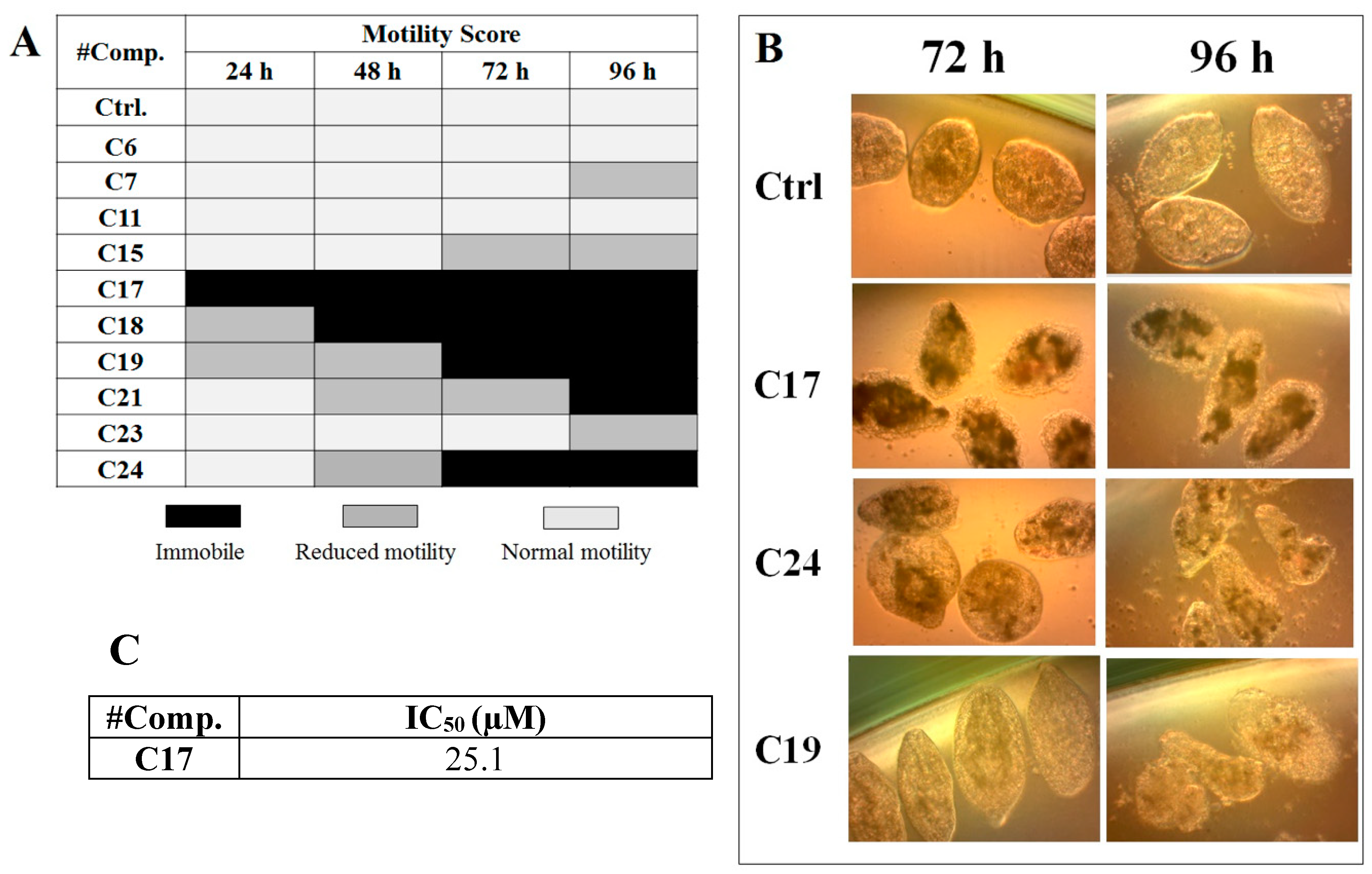

| IC50 (µM) | C7 | C17 | C18 | C19 | C23 | C24 |
|---|---|---|---|---|---|---|
| FhCL1 | 3.5 | 1.7 | 9.0 | 5.0 | 3.0 | 1.4 |
| FhCL3 | 5.2 | 4.9 | 8.0 | >50 | 11 | 0.9 |
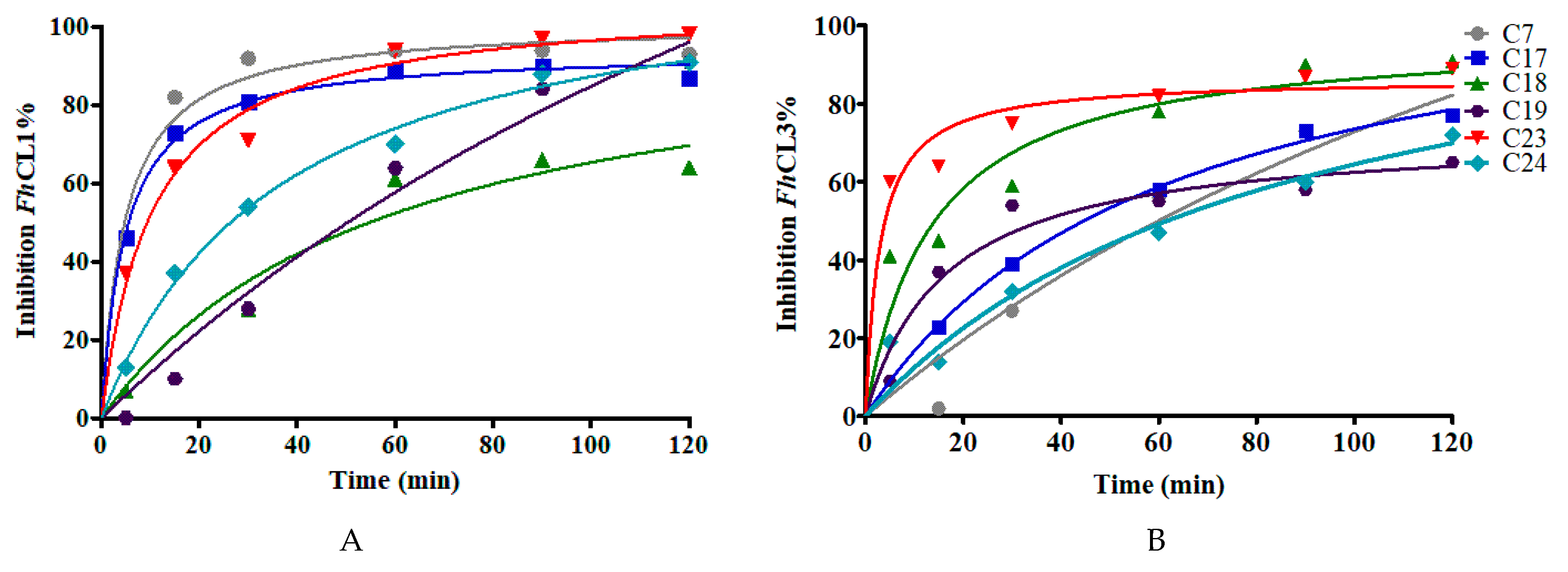
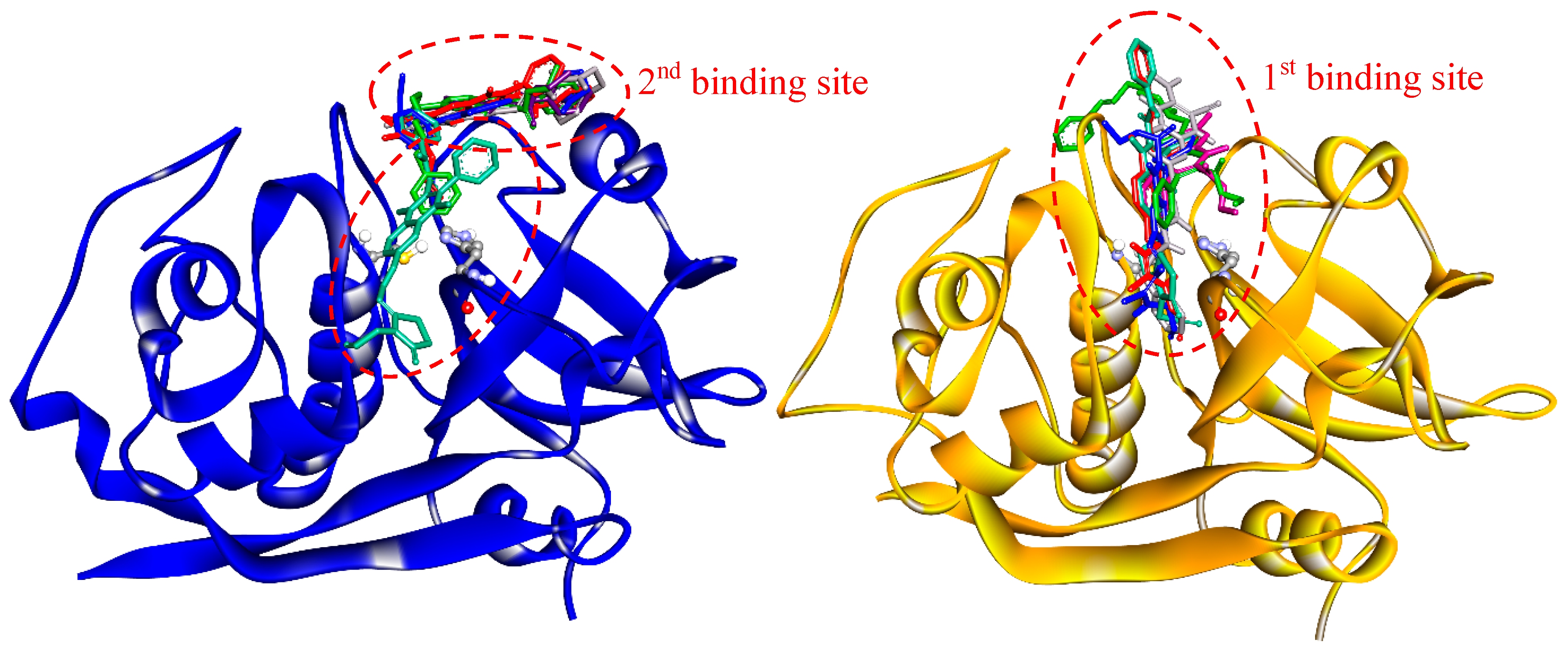
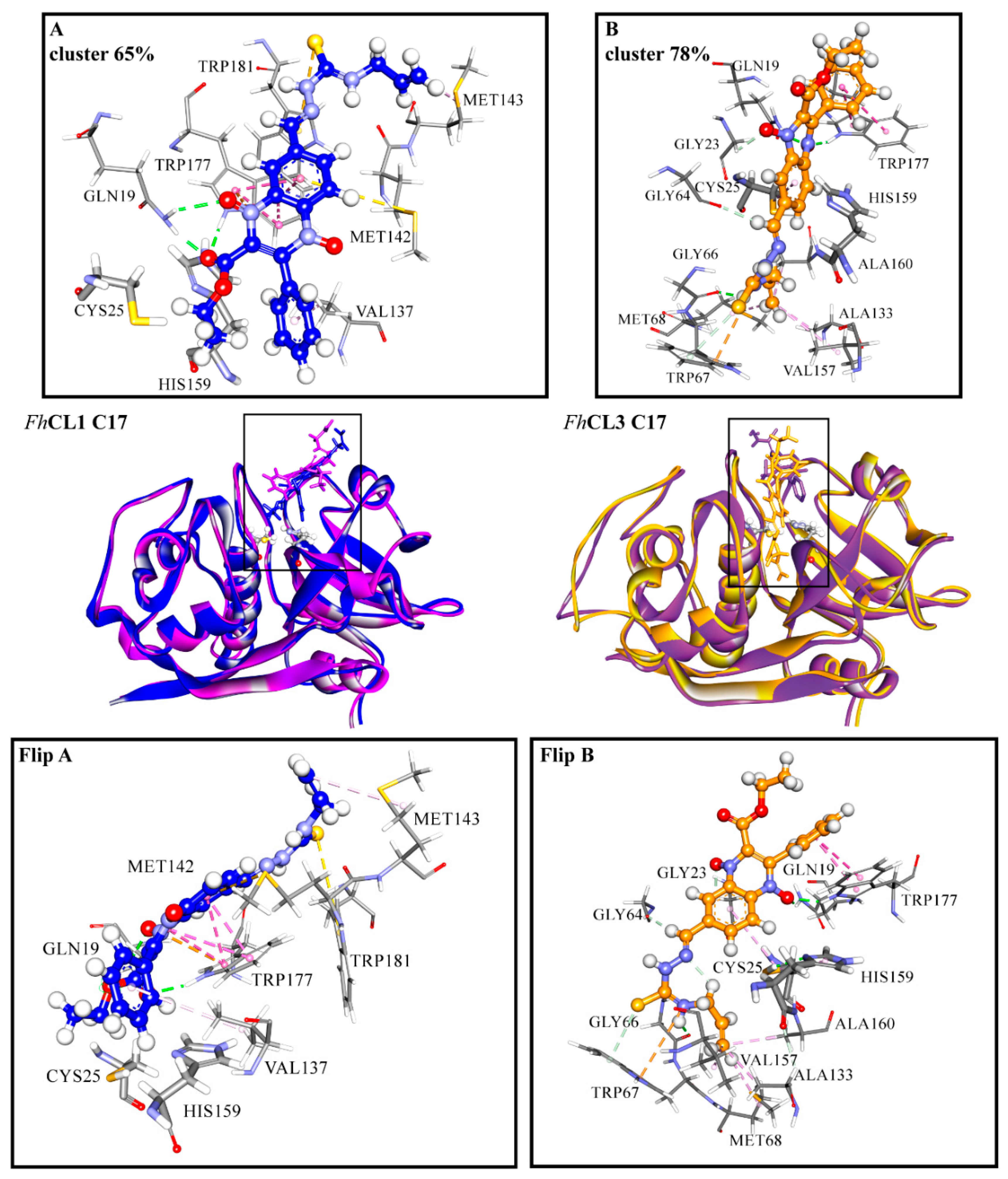
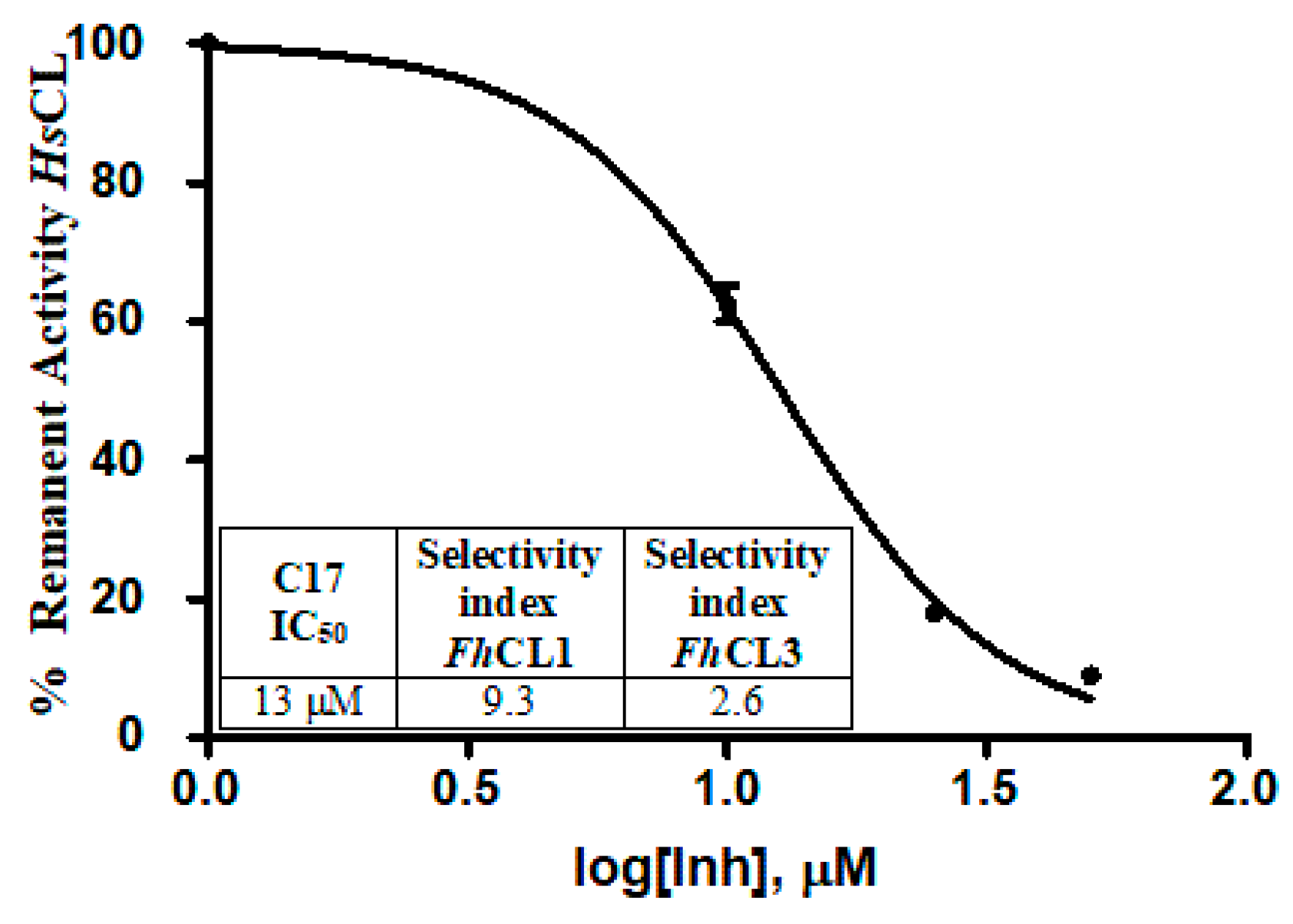
| Comp. (10 μM) | HsCL inhib.% | FhCL1 inhib.% | FhCL3 inhib.% |
|---|---|---|---|
| C7 | 41 | 90 | 61 |
| C17 | 37 | 98 | 86 |
| C18 | 25 | 55 | 61 |
| C19 | 0 | 54 | 35 |
| C23 | 57 | 97 | 79 |
| C24 | ND | 93 | 81 |
| Quinoxalines General Structures | 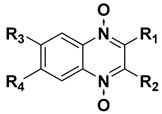 | |||||
|---|---|---|---|---|---|---|
| #Comp. | R1 | R2 | R3 | R4 | %Inh FhCL1 | %Inh FhCL3 |
| C1 | -CH3 | -H | -H | -H | 1 | 8 |
| C2 | -CHO | -H | -H | -H | 21 | 0 |
| C3 | -CN | -NH2 | -H | -H | 30 | 0 |
| C4 | -CN | -NH2 |  | -H | 0 | 27 |
| C5 | -CN | -NH2 |  | -H | 20 | 39 |
| C6 | -CN | -NH2 |  | -H | 59 | 27 |
| C7 | -CN | -NH2 |  | -H | 90 | 61 |
| C8 | -CN | -NH2 |  | -H | 24 | 45 |
| C9 | -CN | -NH2 | -Cl | -Cl | 15 | 0 |
| C10 | -CH3 | -CH3 |  | -H | 13 | 3 |
| C11 | -CH3 | -CH3 |  | -H | 56 | 32 |
| C12 | -CH3 | -CH3 | -H |  | 0 | 22 |
| C13 | -CH3 | -CH3 | -H |  | 34 | 2 |
| C14 |  | -CH3 | -H | -H | 28 | 5 |
| C15 |  | -CH3 |  | -H | 38 | 58 |
| C16 | -CH3 |  | -Cl | -Cl | 35 | 22 |
| C17 |  | -Ph |  | -H | 98 | 86 |
| C18 |  | -Ph |  | -H | 55 | 61 |
| C19 |  | -Ph | -Cl | -Cl | 54 | 35 |
| C20 |  | -CH3 |  | -H | 72 | 0 |
| C21 |  | -CH3 |  | -H | 47 | 54 |
| C22 |  | -CH3 |  | -H | 23 | 49 |
| C23 |  | -Ph | -H |  | 97 | 79 |
| C24 |  | -Ph | -H |  | 93 | 81 |
| C25 |  | -CH3 | -H | -H | 47 | 40 |
| C26 |  | -CH3 | -F | -F | 41 | 17 |
| C27 |  | -CF3 | -H | -H | 38 | 22 |
| C28 | -CF3 |  | -F | -F | 0 | 38 |
| Enzyme | S3 | S2/S3 | S2 | |||||||
|---|---|---|---|---|---|---|---|---|---|---|
| Papain# | 61 | 64 | 66 | 67 | 137 | 142 | 143 | 157 | 160 | 205 |
| FhCL1 | Asn64 | Gly67 | Gly69 | Leu70 | Val139 | Met144 | Met145 | Val161 | Ala164 | Leu210 |
| FhCL3 | His64 | Gly67 | Gly69 | Trp70 | Ala139 | Tyr144 | Met145 | Thr161 | Ala164 | Val210 |
| HsCL | Glu63 | Asn66 | Gly68 | Leu69 | Gly139 | Leu144 | Phe145 | Met161 | Gly164 | Ala214 |
| Comp# | HepG2 IC50 (µM) | Sperm Motility RTC * (50 µM) |
|---|---|---|
| C17 | 48 ± 0.3 | 81 ± 3 |
| C18 | <6.2 | 82 ± 2 |
| C23 | 12 ± 0.2 | 82 ± 1 |
| C24 | 16 ± 0.1 | 82 ± 1 |
| TCBZ | 32 ± 0.2 | 88 ± 1 |
© 2019 by the authors. Licensee MDPI, Basel, Switzerland. This article is an open access article distributed under the terms and conditions of the Creative Commons Attribution (CC BY) license (http://creativecommons.org/licenses/by/4.0/).
Share and Cite
Ferraro, F.; Merlino, A.; Gil, J.; Cerecetto, H.; Corvo, I.; Cabrera, M. Cathepsin L Inhibitors with Activity against the Liver Fluke Identified From a Focus Library of Quinoxaline 1,4-di-N-Oxide Derivatives. Molecules 2019, 24, 2348. https://doi.org/10.3390/molecules24132348
Ferraro F, Merlino A, Gil J, Cerecetto H, Corvo I, Cabrera M. Cathepsin L Inhibitors with Activity against the Liver Fluke Identified From a Focus Library of Quinoxaline 1,4-di-N-Oxide Derivatives. Molecules. 2019; 24(13):2348. https://doi.org/10.3390/molecules24132348
Chicago/Turabian StyleFerraro, Florencia, Alicia Merlino, Jorge Gil, Hugo Cerecetto, Ileana Corvo, and Mauricio Cabrera. 2019. "Cathepsin L Inhibitors with Activity against the Liver Fluke Identified From a Focus Library of Quinoxaline 1,4-di-N-Oxide Derivatives" Molecules 24, no. 13: 2348. https://doi.org/10.3390/molecules24132348
APA StyleFerraro, F., Merlino, A., Gil, J., Cerecetto, H., Corvo, I., & Cabrera, M. (2019). Cathepsin L Inhibitors with Activity against the Liver Fluke Identified From a Focus Library of Quinoxaline 1,4-di-N-Oxide Derivatives. Molecules, 24(13), 2348. https://doi.org/10.3390/molecules24132348






